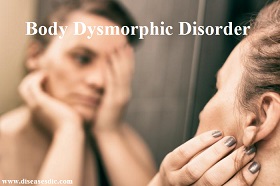Definition
Body Dysmorphic Disorder is a chronic mental illness in which individuals obsess over some perceived flaw in their appearance. This obsession typically takes over the person’s life to the point where they are unwilling to be seen in public and may take drastic and dangerous actions in an attempt to fix or hide the flaw. The two main types of body dysmorphia include non-delusional dysmorphia, where a person exaggerates a minor flaw, or delusional body dysmorphia, where a person has hallucinations of an imagined defect. In either case, the imagined flaws are typically inexistent or mostly unnoticeable by others.
Body Dysmorphic Disorder
They stay focused on their negative thoughts, and think that even small or invisible body imperfection is a cause for great concern. These thoughts cause severe emotional distress and interfere with daily functioning. BDD most often develops in adolescents and teens, and research shows that it affects men and women almost equally.
Epidemiology
The point prevalence of (BDD) in the general population is approximately 2 percent and the prevalence in females and males appears to be comparable or slightly higher in females. The point prevalence in clinical settings is generally higher, ranging from about 3 to 40 percent, depending upon the study sample. Mean age of onset is approximately 17 years, and onset is usually gradual rather than abrupt. BDD has been reported in many countries.
Types
There are two subtypes of BDD. Muscle Dysmorphia and BDD by Proxy. Both of these subtypes appear to respond to the same basic treatment strategies as BDD (cognitive behavior therapy or CBT and medications). However, the CBT therapist in particular needs to adjust the treatment so that it has the right focus. Please see below for some of the differences between BDD and BDD subtypes.
Muscle Dysmorphia (MD)
Muscle dysmorphia, or MD, is a subtype of body dysmorphic disorder (BDD). MD is associated with a number of thoughts and beliefs about one’s self and others, including:
- Beliefs that one’s body is not sufficiently muscular and large enough
- Over-valuing appearance
- Intrusive negative thoughts about one’s body that leads to distractibility and difficulty focusing attention
- Belief that others negatively evaluate their appearance
Body Dysmorphic Disorder by Proxy
Body dysmorphic disorder by proxy (BDDBP) is a variation of BDD in which an individual is overly concerned with perceived imperfections with another person’s appearance.
Risk factors
Certain factors seem to increase the risk of developing or triggering the condition, including:
- Having biological relatives with body dysmorphic disorder
- Childhood teasing
- Physical or sexual abuse
- Low self-esteem
- Societal pressure or expectations of beauty
Causes of Body Dysmorphic Disorder
It is not fully understood what causes body dysmorphic disorder. Genetics may play a part, but so might factors such as:
- Teasing or verbal abuse concerning appearance
- An overemphasis on appearance among family or friends
- Sexual abuse and related feelings of worthlessness.
Some people with body dysmorphic disorder also have mental illness in their family.
Symptoms and Signs
People suffering from BDD often lack self-esteem, may be self-conscious around others and avoid social situations. They may also seek medical reassurance about a particular physical feature that is often not noticeable to others.
Other signs include:
- Frequently comparing the appearance of the perceived flaw with that of others
- Avoiding mirrors
- Excessive grooming (e.g. combing hair, shaving, removing or cutting hair, applying makeup)
- Frequently checking appearance of specific part in mirrors and other reflective surfaces
- Camouflaging the perceived defect with clothing, makeup, hats, hands, or posture
- Seeking reassurance about the flaw or attempting to convince others of its ugliness
- Frequently touching the perceived defect.
Complications of Body Dysmorphic Disorder
Complications that may be caused by or associated with body dysmorphic disorder include, for example:
- Major depression or other mood disorders
- Suicidal thoughts or behaviour
- Anxiety disorders
- Health problems from behaviours such as skin picking
- Obsessive-compulsive disorder
- Eating disorders
- Substance abuse
Diagnosis and test
Diagnosis of BDD is difficult for many reasons, including:
- People with BDD are more likely to seek help from dermatologists and cosmetic surgeons than psychologists and psychiatrists.
- People with BDD are ashamed and don’t want to seek help from mental health professionals.
- This type of mental illness doesn’t get much publicity, so some health professionals may not even be aware that BDD exists.
- BDD is similar to many other conditions and misdiagnosis is possible.
Treatment and medications
BDD is not always easy to treat but the treatments that seem to help the most include a combination of:
Cognitive behaviour therapy (CBT) – Training in how to change underlying attitudes in order to think and feel in different ways. This includes learning to tolerate the distress of ‘exposing’ their perceived defect to others and in not performing rituals related to appearance concerns
Coping and management skills – Training in how to cope with symptoms of anxiety. For example, the person may learn relaxation techniques and how to combat hyperventilation
Medication – Including antidepressant medications, particularly selective serotonin reuptake inhibitors (SSRIs). These medications help reduce many BDD symptoms, including the compulsive thoughts, depression and anxiety. Generally, medications are used in combination with psychotherapy.
Some people with body dysmorphic disorder seek cosmetic surgery to ‘correct’ an actual or perceived physical flaw. Medical experts are divided on the ethics of performing cosmetic surgery under these circumstances (sometimes called ‘non-therapeutic mutilation’ or extreme body modification).
Any medical or surgical procedure carries health risks. Unnecessary attempts to change appearance through surgery may lead to dissatisfaction with the results and could worsen a person’s BBD.
Prevention of Body Dysmorphic Disorder
There’s no known way to prevent body dysmorphic disorder. However, because body dysmorphic disorder often starts in the early teenage years, identifying the disorder early and starting treatment may be of some benefit.
Long-term maintenance treatment also may help prevent a relapse of body dysmorphic disorder symptoms.

